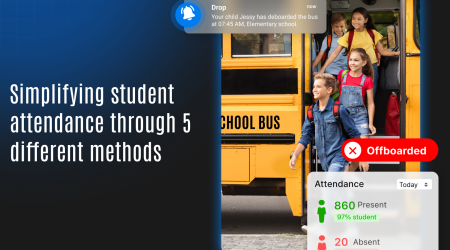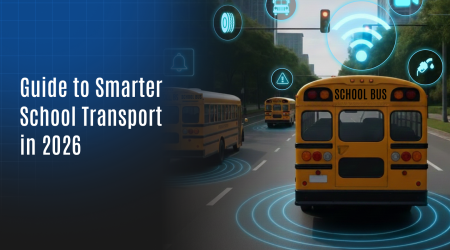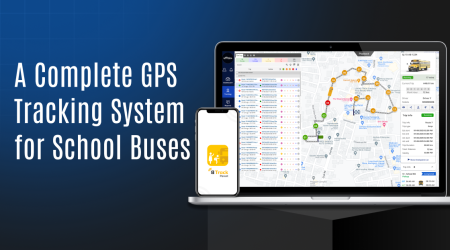How Efficient Route Planning Reduces Operational Costs for School Transportation

Optimized route planning is crucial for transport businesses aiming to reduce expenses and enhance service quality. A transportation company, a leader in school transportation services, has embraced technology to optimize its routes. By implementing school bus monitoring software, they have significantly reduced operational costs and enhanced the safety and reliability of their services. This success story explores how they achieved these results, detailing the steps they took, the challenges they faced, and the benefits they reaped.
Introduction to the Transportation Company
The transportation company has been in the school transportation business for over two decades. With a fleet of over 200 buses, they transport thousands of students daily across multiple districts. Their dedication to safety and dependability is unmatched. However, with rising fuel costs and increasing operational expenses, JKL Transportation needed a solution to maintain their high standards while controlling costs.
The Challenge: Rising Operational Costs
In recent years, the transportation company faced several significant challenges that threatened their operational efficiency and financial stability. One of the foremost issues was the fluctuating fuel prices, which made budgeting a daunting task and invariably increased overall costs. Frequent and unpredictable bus maintenance also added to operational expenses, as unexpected breakdowns and repairs disrupted schedules and strained the budget. Ensuring driver efficiency and managing their schedules became increasingly complex, contributing to administrative headaches and inefficiencies. Additionally, safety concerns were paramount, with the need to ensure student safety and reduce incidents on the road becoming more critical than ever. These challenges underscored the necessity for a more efficient system to manage routes and operations effectively.
The Solution: School Bus Monitoring Software
To address these pressing issues, the transportation company decided to implement a comprehensive school bus monitoring software. This strategic decision was driven by the need for a solution that could simultaneously optimize routes for fuel efficiency, monitor bus maintenance needs proactively, manage driver schedules, and enhance student safety with real-time monitoring. After careful consideration, they chose a robust school bus monitoring system known for its efficiency and user-friendly interface. The software promised to streamline operations, providing real-time data that would facilitate better decision-making. By leveraging this technology, JKL Transportation aimed to transform their operational landscape, reduce costs, and improve service quality.
Implementation Process
The implementation of the school bus monitoring software at the transportation company was carried out in several stages. Initially, they conducted a thorough assessment of their current routes and operations to identify inefficiencies. Following this, the software was installed on all buses, and drivers were trained to use the new system effectively. Historical data was integrated into the system to provide a baseline for measuring improvements. They then launched a pilot phase to test the software and make necessary adjustments. After successful testing, the software was fully deployed across the entire fleet, marking a new era in their operational strategy.
The Benefits of Efficient Route Planning
The advantages of deploying the school bus monitoring software became evident and significant right away. By optimizing routes, the transportation company saw a significant reduction in fuel consumption. The software identified the shortest and most efficient routes, saving thousands of dollars in fuel costs annually. Maintenance costs also saw a reduction, as the software provided real-time data on bus performance, allowing for proactive maintenance. This reduced unexpected breakdowns and extended the lifespan of the buses. Driver schedules were optimized, and their performance was monitored in real-time, leading to increased efficiency and better compliance with safety standards. Real-time monitoring of buses ensured quick responses to any incidents. Parents and school administrators were also given access to track the buses, increasing transparency and peace of mind.
Success in Numbers: Cost Savings Analysis
To quantify the impact of efficient route planning, let’s look at some numbers. Before implementing the school bus monitoring software, the transportation company was spending approximately $1.5 million annually on fuel. Post-implementation, fuel costs dropped by 15%, saving around $225,000 per year. Maintenance costs also saw a reduction. Previously, JKL Transportation spent about $500,000 annually on maintenance. With proactive monitoring, these costs were reduced by 20%, saving another $100,000 annually. In terms of driver management, the software reduced overtime costs and improved scheduling efficiency, resulting in a further $50,000 in annual savings. In total, JKL Transportation saved around $375,000 annually, highlighting the significant financial benefits of efficient route planning.
Enhanced Customer Satisfaction
Beyond cost savings, efficient route planning and real-time monitoring enhanced customer satisfaction. Parents appreciated the transparency and the ability to track their children’s buses. Schools reported fewer delays and incidents, leading to a smoother transportation experience for students. This improvement in service quality translated into higher levels of trust and satisfaction among all stakeholders.
Future Plans for JKL Transportation
Encouraged by the success of the school bus monitoring software, the transportation company plans to expand its use. They are exploring additional features like predictive analytics, using historical data to predict and prevent potential issues. Advanced safety features, such as cameras and sensors, are also being considered for enhanced safety monitoring. Furthermore, they are looking into integrating the software with school attendance systems for better coordination and efficiency.
Lessons Learned
The journey of JKL Transportation offers valuable lessons for other transportation companies. Investing in technology can transform operations and yield significant cost savings. Proper training ensures that drivers and staff can maximize the benefits of new systems. Continuous monitoring and analysis help in identifying areas for further improvement. Involving parents and schools in the process increases transparency and trust, fostering a collaborative environment that enhances service quality.
Some Frequently Asked Questions
Q: How does efficient route planning save fuel?
A: By identifying the shortest and least congested routes, efficient route planning minimizes the distance and time buses spend on the road, reducing fuel consumption.
Q: What are the safety benefits of school bus monitoring software?
A: The software provides real-time tracking and alerts for any deviations or incidents, ensuring quick responses and enhanced safety for students.
Q: Can the software be tailored to various requirements?
A: Yes, many school bus monitoring software solutions provide customizable options to accommodate the unique needs of diverse transportation companies.
Q: How does proactive maintenance work?
A: The software monitors the performance of buses and alerts for any potential issues before they become serious problems, allowing for timely maintenance and reducing unexpected breakdowns.
Q: What is the cost of implementing such software?
A: The cost varies depending on the size of the fleet and the specific features required. However, the long-term savings in fuel, maintenance, and operational efficiency typically outweigh the initial investment.
In Summary
Efficient route planning has proven to be a game-changer for the transportation company, reducing operational costs and enhancing service quality. By leveraging advanced school bus monitoring software, they have optimized routes, improved safety, and achieved significant cost savings. For transportation companies looking to reduce costs and improve efficiency, investing in route planning technology is a smart move. The success of the company serves as a testament to the potential benefits of such an investment. As they continue to innovate and improve their operations, the company sets a benchmark for excellence in school transportation services.


